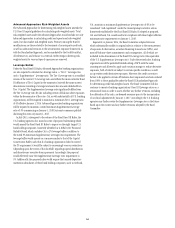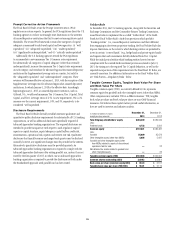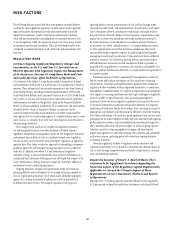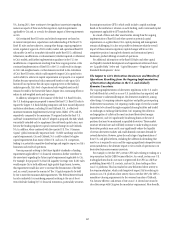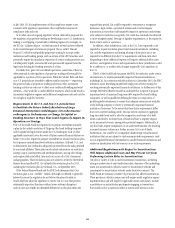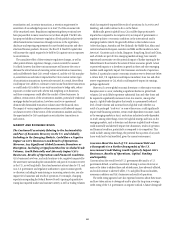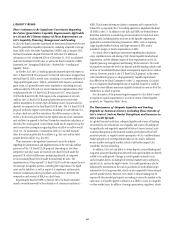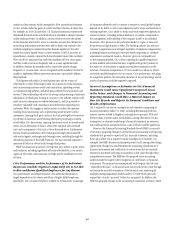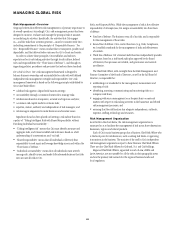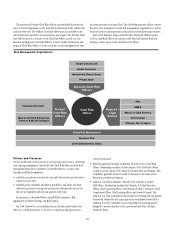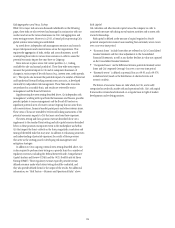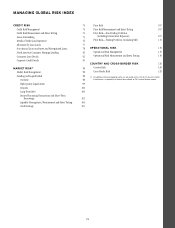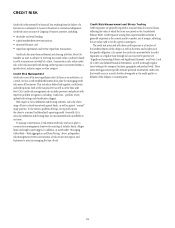Citibank 2013 Annual Report Download - page 82
Download and view the complete annual report
Please find page 82 of the 2013 Citibank annual report below. You can navigate through the pages in the report by either clicking on the pages listed below, or by using the keyword search tool below to find specific information within the annual report.64
oversight by the OCC and other bank regulators, and inquiries and
investigations by other governmental and regulatory authorities, with respect
to its anti-money laundering program. Other institutions subject to similar
or the same inquiries, actions or investigations as those above have incurred
substantial liability in relation to their activities in these areas, including in a
few cases criminal convictions or deferred prosecution agreements respecting
corporate entities as well as substantial fines and penalties.
Moreover, regulatory changes resulting from the Dodd-Frank Act
and other recent regulatory changes - such as the limitations on federal
preemption in the consumer arena, the creation of the Consumer Financial
Protection Bureau with its own examination and enforcement authority and
enhanced consumer protections globally, as well as the “whistle-blower”
provisions of the Dodd-Frank Act - could further increase the number of
legal and regulatory proceedings against Citi. In addition, while Citi takes
numerous steps to prevent and detect employee misconduct, such as fraud,
employee misconduct cannot always be deterred or prevented and could
subject Citi to additional liability or losses.
These matters have resulted in, and will likely continue to result in,
significant time, expense and diversion of management’s attention. In
addition, they may result in adverse judgments, settlements, fines, penalties,
restitution, disgorgement, injunctions, business improvement orders or
other results adverse to it, which could materially and negatively affect Citi’s
businesses, business practices, financial condition or results of operations,
require material changes in Citi’s operations, or cause Citi reputational
harm. Moreover, many large claims asserted against Citi are highly complex
and slow to develop, and they may involve novel or untested legal theories.
The outcome of such proceedings is difficult to predict or estimate until
late in the proceedings, which may last several years. In addition, certain
settlements are subject to court approval and may not be approved. Although
Citi establishes accruals for its legal and regulatory matters according to
accounting requirements, the amount of loss ultimately incurred in relation
to those matters may be substantially higher than the amounts accrued.
For additional information relating to Citi’s legal and regulatory
proceedings, see Note 28 to the Consolidated Financial Statements.
BUSINESS AND OPERATIONAL RISKS
Citi’s Results of Operations Could Be Negatively Impacted
as Its Revolving Home Equity Lines of Credit Begin
to “Reset.”
As of December 31, 2013, Citi’s home equity loan portfolio of approximately
$31.6 billion included approximately $18.9 billion of home equity lines of
credit that were still within their revolving period and had not commenced
amortization, or “reset” (Revolving HELOCs). Of these Revolving HELOCs,
approximately 72% will commence amortization during the period
of 2015-2017.
Before commencing amortization, Revolving HELOC borrowers are
required to pay only interest on their loans. Upon amortization, these
borrowers will be required to pay both interest, typically at a variable rate,
and principal that amortizes over 20 years, rather than the typical 30-year
amortization. As a result, Citi’s customers with Revolving HELOCs that reset
could experience “payment shock” due to the higher required payments on
the loans. Increases in interest rates could further increase these payments,
given the variable nature of the interest rates on these loans post-reset.
Based on the limited number of Citi’s Revolving HELOCs that have reset
as of December 31, 2013, Citi has experienced a higher 30+ days past due
delinquency rate on its amortizing home equity loans as compared to its total
outstanding home equity loan portfolio (amortizing and non-amortizing).
These resets have generally occurred during a period of declining interest
rates, which Citi believes has likely reduced the overall payment shock to
borrowers. While Citi continues to review its options, increasing interest rates,
stricter lending criteria and borrower loan-to-value positions could limit
Citi’s ability to reduce or mitigate this reset risk going forward. Accordingly,
as these loans begin to reset, Citi could experience higher delinquency rates
and increased loan loss reserves and net credit losses in future periods, which
could be significant and would negatively impact its results of operations.
For additional information on Citi’s Revolving HELOCs portfolio, see
“Managing Global Risk—Credit Risk—North America Consumer Mortgage
Lending” below.
Citi’s Ability to Return Capital to Shareholders
Substantially Depends on the CCAR Process and the Results
of Required Regulatory Stress Tests.
In addition to Board of Directors’ approval, any decision by Citi to return
capital to shareholders, whether through an increase in its common stock
dividend or through a share repurchase program, substantially depends
on regulatory approval, including through the annual Comprehensive
Capital Analysis and Review (CCAR) process required by the Federal Reserve
Board and the supervisory stress tests required under the Dodd-Frank Act.
Restrictions on Citi’s ability to return capital to shareholders as a result of
these processes has negatively impacted market perceptions of Citi, and could
do so in the future.
Citi’s ability to accurately predict or explain to stakeholders the outcome
of the CCAR process, and thus address any such market perceptions, may
be complicated by the Federal Reserve Board’s evolving criteria employed
in its overall aggregate assessment of Citi. The Federal Reserve Board’s
assessment of Citi is conducted not only by using the Board’s proprietary
stress test models, but also a number of qualitative factors, including a
detailed assessment of Citi’s “capital adequacy process,” as defined by the
Federal Reserve Board. The Federal Reserve Board has stated that it expects
leading capital adequacy practices will continue to evolve and will likely be
determined by the Federal Reserve Board each year as a result of the Board’s
cross-firm review of capital plan submissions.
Similarly, the Federal Reserve Board has indicated that, as part of its stated
goal to continually evolve its annual stress testing requirements, several


